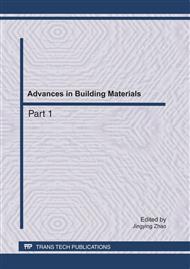p.394
p.398
p.402
p.407
p.411
p.416
p.421
p.426
p.431
Study on the Workability of High Strength Concrete with the Grading of Coarse Aggregate Skeleton Structure
Abstract:
People often use superplasticizer and mineral admixtures (such as steel slag, slag, etc.) to increase the density of concrete and improve concrete strength, but don’t use coarse aggregate gradding. The paper selects the coarse aggregate of skeleton structure from several grading concept, and uses Uniform Design to test high strength concrete workability, and analyses results. It is shown from the results that the method of Uniform Design can significantly reduce the workload, and concrete mixture slump increases linearly with the water-cement ratio and sand percentage, but decreases linearly with steel slag addition, and the water released from the flocculation of cement by superplasticizer can increase the slump, and most of water plays the role of lubricant before it reacts with cement, and the effect of slump that sand extends coarse aggregate skeleton are greater than that sand surface area increases.
Info:
Periodical:
Pages:
411-415
Citation:
Online since:
May 2011
Authors:
Keywords:
Price:
Сopyright:
© 2011 Trans Tech Publications Ltd. All Rights Reserved
Share:
Citation:


